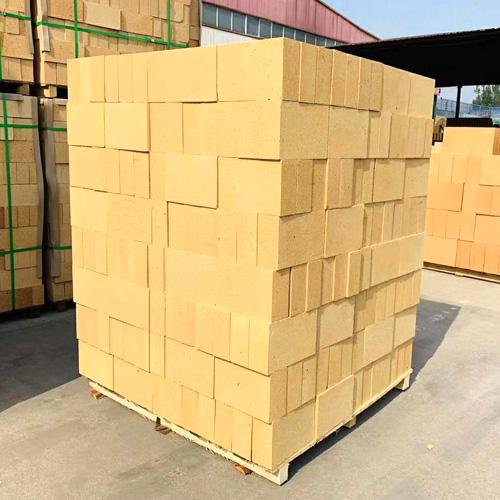
Fireclay bricksis suitable for supporting hot blast stoves of large, medium and small blast furnaces
Physical and chemical indicators of low creep rate clay bricks
Fire clay bricks use super-grade coke gemstone, mullite and andalusite as the main raw materials, and use grade 3 ingredients and mixed fine grinding to produce high-quality hot blast stove bricks. It has been similar to Japanese products and has reached the product indicators of similar foreign products.
Clay bricks are suitable for supporting hot blast stoves of large, medium and small blast furnaces, and are mainly used in heat storage middle and lower walls, lower lattice bricks, supporting strings and other parts.
|
term |
Specified value |
||||
|
DRN-125 |
DRN-120 |
DRN-115 |
DRN-110 |
||
|
Al2O3%≥ |
45 |
42 |
40 |
36 |
|
|
Bulk density/(g/cm3) |
2.15~2.35 |
2.00~2.20 |
2.00~2.20 |
2.00~2.20 |
|
|
Compressive creep rate(0.2Mpa ×50h) |
1250℃ 0.8 |
1200℃ 0.8 |
1150℃ 0.8 |
1100℃ 0.8 |
|
|
Heating permanent line rate of change/% |
(1400℃×2h) |
-0.3~+0.1 |
- |
- |
- |
|
(1350℃×2h) |
- |
-0.3~0.1 |
- |
- |
|
|
(1300℃×2h) |
|
|
-0.4~0.1 |
-0.4~0.1 |
|
|
Apparent porosity/%≤ |
22(24) |
22(24) |
22(24) |
22(24) |
|
|
Normal temperature compressive strength/MPa≥ |
40 |
35 |
30 |
25 |
|
|
1:The data in parentheses are the indicators of the regenerator checkered bricks 2: The volume density index is the reference index of the design brick quantity, not for reference
|
|||||
Fireclay bricks are classified as weak acid refractories. Due to the large fluctuation range of chemical composition, different production methods, and differences in firing temperature, the properties of clay bricks change greatly.We can produce all kinds of Fireclay bricks according to customers' requirements
low porosity clay bricks are mainly used in the regenerators of glass kilns. They can also be used in blast furnaces and hot blast furnaces in the steel industry; cement kilns in the building materials industry; chemical kilns in the chemical industry as kiln linings
The Al2O3 content of clay heat Clay insulating refractory bricks is generally more than 40%, and the Fe2O3 content is less than 2.0-2.5%. The clinker in the ingredients is 65-85%, and the combined clay is 35-15%. The crushed bonded clay and the finely ground clinker are mixed and milled, and then mixed with the granular clinker to make semi-dry mud, high pressure molding, and sintering at about 1400 ℃, with good performance.
The refractoriness of clay bricks is comparable to that of silica bricks, up to 1690~1730℃, but the softening temperature under load is more than 200℃ lower than that of silica bricks. Because in addition to the high refractory mullite crystal, the clay brick also contains nearly half of the low melting point amorphous glass phase.
Magnesia alumina bricks use periclase as the main crystal phase and magnesia-alumina spinel as the matrix. They are better in thermal shock resistance than magnesia bricks. In order to improve the thermal shock resistance of magnesia bricks, alumina or alumina is introduced into the ingredients. Bauxite clinker fine powder to form a magnesia-alumina sharp stone matrix, thereby making magnesia-alumina bricks
High alumina refractory mortars used in kilns in metallurgy, building materials, machinery, chemical industry, electric power and other industries, used for masonry clay bricks, high alumina bricks, corundum bricks, with full ash joints, good air tightness of masonry, high bonding strength, high temperature performance Excellent, suitable for construction time and so on.
The high-alumina bricks are mainly used in the regenerator of the hot blast stove. The lattice bricks with a certain structure are arranged in an orderly manner, and the upper and lower through holes of the lattice bricks can allow the gas to pass through.
Refractory ramming mass (refractory taphole mass) is a kind of Refractory used for lining of blast furnace tapping groove. It is mainly used to protect the blast furnace out of the ditch from high-temperature hot metal and slag erosion and erosion, and has excellent high-temperature resistance and wear resistance. The ramming material for the iron discharge ditch is usually composed of corundum, silicon carbide and carbonaceous material, which has the ability of resisting hot metal and molten slag erosion and scouring, reburning line change small, strong resistance to a variety of oxidation characteristics. The construction of the ramming material for the iron ditch is convenient, easy to dismantle and repair, does not produce harmful gas, and is beneficial to environmental protection.



